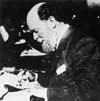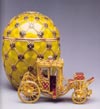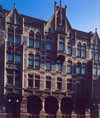Faberge Imperial Easter Eggs
www.Gatchino.com/Jeweller/Faberge/

FabergeImperialEasterEggs
Èìïåðàòîðñêèå ïàñõàëüíûå ÿéöà Ôàáåðæå
History of Faberge
Although patriotic, Faberge did not spend too much time dwelling time on the current state of Russia – he was far too busy designing objects of fantasy. In 1895 Faberge’s profits doubled when Nicholas II commissioned him to design two Easter Eggs. The Danish Palace Egg went to his mother.

The Rosebud was made for Alexandra. Faberge’s work continued to reflect personal and public events of the Royal family.
The coronation of Nicholas II and Empress Alexandra of 1896 was without any question the last such event in history. There will never be another spectacle like this anywhere. It was a huge, magnificent religious reception. A million of citizens descended upon Moscow to catch a glimpse of their new Emperor and Empress. This momentum inspired Faberge to design The Coronation Egg.

Every egg produced by Faberge for Royal Family were eggs
of a personal and historic nature. The personal ones truly illustrate
the love Nicholas II had for his family and wife. Faberge’s Imperial Eggs
and objects of fantasy became famous throughout Russia. By the turn of
a century his shop became known as the House of Faberge and was imposing
five story granite building. Inside he employed over 500 craftsmen and
designers.  The large main sales room was on the ground floor, and the
building included an art studio for the designers and sculptors and a
large library. On the top floor was Carl Faberge’s own luxurious 15 room
apartment, arranged with his own famous taste. Like any father, he was
proud when his four sons joined the company. Branches were opened in Moscow,
Odessa and Kiev.
The large main sales room was on the ground floor, and the
building included an art studio for the designers and sculptors and a
large library. On the top floor was Carl Faberge’s own luxurious 15 room
apartment, arranged with his own famous taste. Like any father, he was
proud when his four sons joined the company. Branches were opened in Moscow,
Odessa and Kiev.

Faberge as far as we know made nothing with his own hands. He, in fact, was not a master of his craft, but he was a visionary, a man who conceived ideas for over one hundred thousand objects. Drawings, raw sketches - and his maters and craftsmen would complete his design. Faberge demanded absolute perfection. He scrutinized every last item made in his workshop. Some say, he smashed all the objects with the gold hammer, but his great granddaughter, Tatiana Faberge says, "He was not that dramatic. He did not take a hammer and break up things, like it was written in several books. If something was not right, he would take the stones out, reuse the gold again, but never broke anything with a hammer."

Faberge was the great perfectionist. He looked back in time as every good artist does look at the generations before him to incorporate wonderful things. And Faberge looked back to the 18th century. He borrowed an enamel technique, but improved this technique in absolutely unbelievable way.
Enamel is a mixture of glass and metal oxide applied to a metal surface,
heated to a very high temperature to make it fluid. Then cooled, hardened
and polished to a glossy smoothness. While French objects of the 18th
century had 6, 7, 8 different colors, Faberge was able to develop over
the forty years of the existence of his firm up to a 140 various color
hues.  People were waiting every year to find out what new colors Faberge
was going to bring out. This is absolutely tremendous, because even
in contemporary time no one is able to do anything like that.
People were waiting every year to find out what new colors Faberge
was going to bring out. This is absolutely tremendous, because even
in contemporary time no one is able to do anything like that.
At no time in history the jeweler had been more identified with the life
and aspirations of his native land. Faberge’s eggs decorated palaces of
Russia. Nicholas and Alexandra were by far his best customers. Because
of that, everyone wanted to own a piece of Faberge.  A small number of
non-imperial eggs remained for very wealthy. Faberge has become very famous
in Russia and it was not long before his work was recognized all over
the world so much so that Queen Alexandra of England persuaded Faberge
to open a shop in London. Still, the humble and modest jeweler remained
unaffected by his own success. "He started in 1870 and it took him
15 years to become very well known. Therefore, for him it came gradually
and through hard work, and he did not really realized how famous he was,"
- says Tatiana Faberge.
A small number of
non-imperial eggs remained for very wealthy. Faberge has become very famous
in Russia and it was not long before his work was recognized all over
the world so much so that Queen Alexandra of England persuaded Faberge
to open a shop in London. Still, the humble and modest jeweler remained
unaffected by his own success. "He started in 1870 and it took him
15 years to become very well known. Therefore, for him it came gradually
and through hard work, and he did not really realized how famous he was,"
- says Tatiana Faberge.